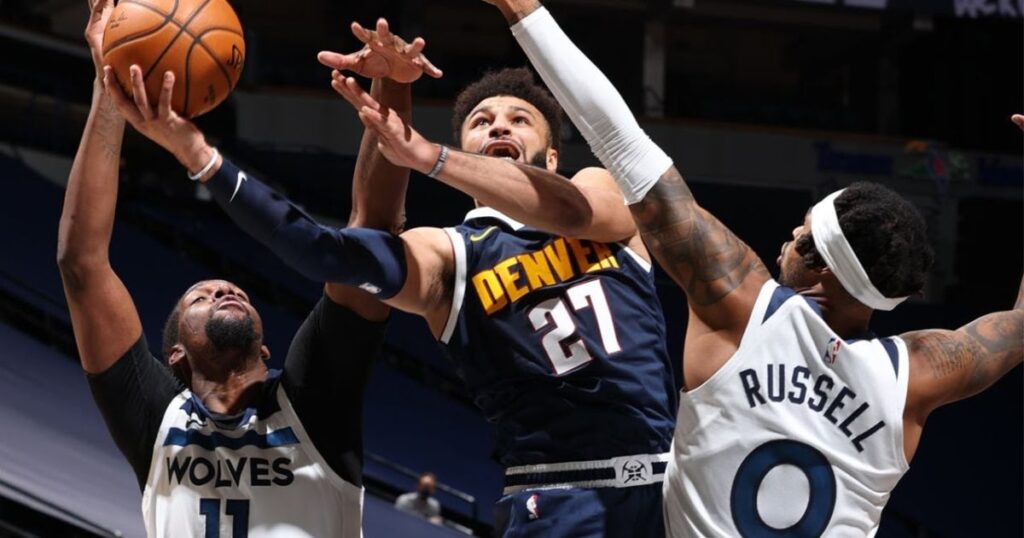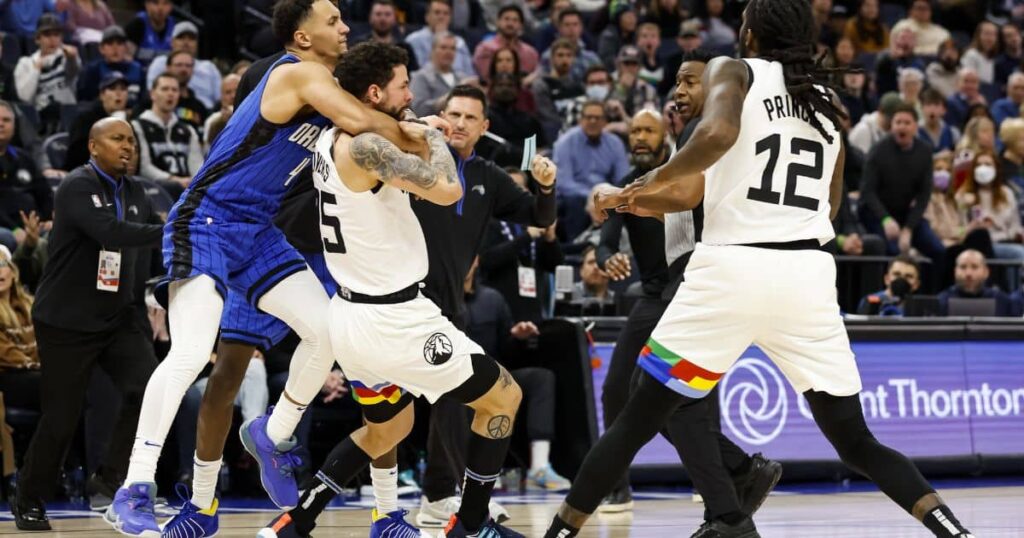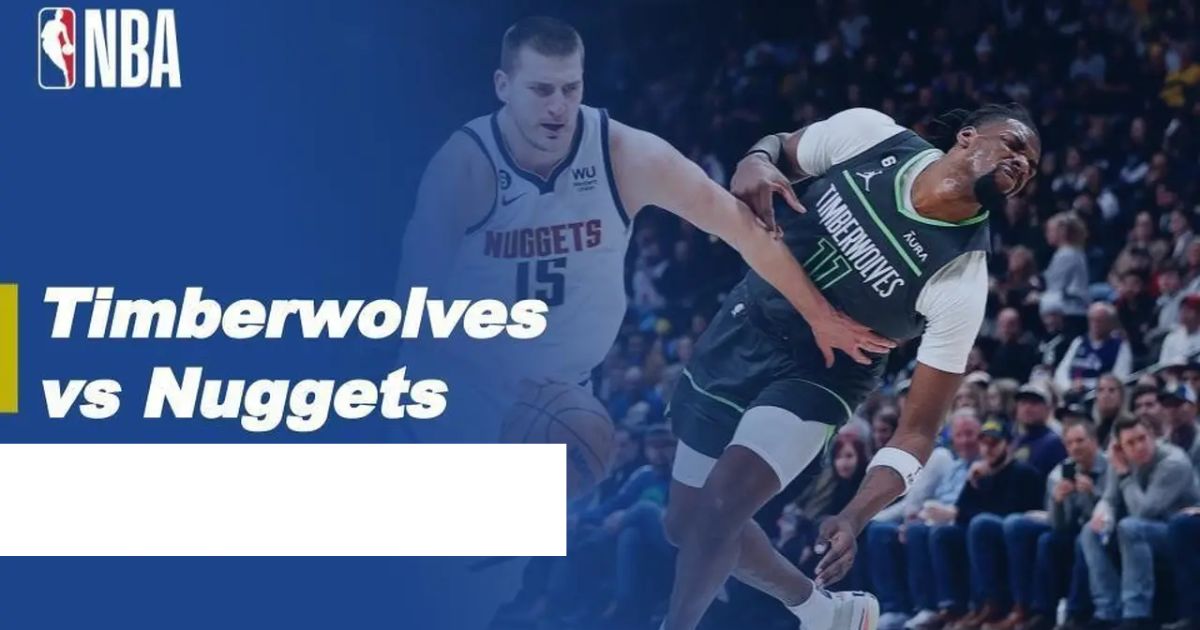Ever wonder what goes on behind the numbers in a high-stakes NBA matchup? Let’s dive into the Timberwolves vs. Denver Nuggets game that had fans on the edge of their seats. We’ll break down the key stats, highlight standout performances, and uncover the strategies that shaped this thrilling contest.
What Were the Timberwolves Vs Denver Nuggets Match Player Stats?
The clash between the Minnesota Timberwolves and the Denver Nuggets on March 15, 2024, was a statistical feast. The Timberwolves shot 45% from the field, nailing 35 of 78 attempts.
From downtown, they managed a 32% success rate, sinking 10 of 31 tries. At the charity stripe, they were solid, hitting 16 of 20 for an 80% clip. On the glass, they snagged 45 rebounds, with 12 on the offensive end.
The team dished out 22 assists, pocketed 7 steals, and swatted away 5 shots. However, they coughed up the ball 13 times.
The Nuggets countered with a 48% field goal percentage, knocking down 38 of 80 shots. They were hot from beyond the arc, draining 14 of 35 for a 40% three-point rate.
At the line, they were nearly automatic, sinking 17 of 20 for an 85% free-throw percentage. They grabbed 42 boards, including 8 offensive rebounds, and tallied 25 assists.
Defensively, they swiped 9 steals and rejected 6 shots. The Nuggets kept their turnovers to 11, giving them a slight edge in ball security.
Who Were the Top Scorers in the Timberwolves Vs Denver Nuggets Match Player Stats?
Karl-Anthony Towns led the charge for the Timberwolves, dropping 28 points on an efficient 11-of-19 shooting. He was a threat from deep, hitting 3 of 6 from three-point range, and perfect at the line, going 3-for-3. Towns wasn’t just a scorer; he pulled down 10 rebounds and dished out 4 assists, showcasing his all-around game.
Anthony Edwards backed up Towns with 24 points of his own. He shot 9-of-20 from the field, including 2-of-7 from beyond the arc. Edwards also contributed 6 rebounds and 5 assists, proving his value as a multi-faceted player.
For the Nuggets, Nikola Jokić was the main man, pouring in 30 points on 12-of-22 shooting. The big man showed his range, knocking down 2 of 5 three-pointers, and was flawless at the line, going 4-for-4. Jokić’s impact extended beyond scoring, as he grabbed 11 rebounds and dished out 8 assists, reinforcing his reputation as one of the league’s most versatile centers.
Jamal Murray provided strong support with 26 points, shooting an efficient 10-of-18 from the field and 4-of-8 from three-point land. He also chipped in 5 rebounds and 6 assists, proving to be a reliable second option for Denver.
How Did the Rebounds Compare Between Timberwolves Vs Denver Nuggets Match Player Stats?
The battle on the boards was closely contested, with the Timberwolves holding a slight edge. Minnesota pulled down 45 total rebounds, including 12 offensive boards. These second-chance opportunities were crucial in keeping them competitive throughout the game. The Timberwolves’ ability to crash the offensive glass gave them extra possessions and put pressure on the Nuggets’ defense.
Denver, while outrebounded overall, still managed to snag 42 rebounds, with 8 coming on the offensive end. Their 34 defensive rebounds helped limit Minnesota’s second-chance points and allowed them to push the pace in transition. The Nuggets’ solid rebounding, despite being slightly outperformed, kept them in the fight and prevented the Timberwolves from dominating the glass.
Which Players Had the Most Assists?
When it came to distributing the rock, D’Angelo Russell was the maestro for the Timberwolves. He orchestrated the offense with 9 assists, consistently finding open teammates and creating scoring opportunities. Russell’s court vision and ability to read defenses were on full display, keeping the Nuggets’ defense on their toes.
For Denver, Nikola Jokić showcased his exceptional passing skills with 8 assists. His ability to find cutters and spot-up shooters from the post or the top of the key made him a nightmare for the Timberwolves’ defense. Jokić’s passing prowess as a center adds a unique dimension to the Nuggets’ offense, making them unpredictable and difficult to guard.
What Was the Defensive Performance Like?
Defense played a crucial role in this tightly contested matchup. The Timberwolves managed to snag 7 steals and block 5 shots. Josh Okogie was a defensive standout, racking up 3 steals and disrupting Denver’s offensive flow. Karl-Anthony Towns anchored the paint with 2 blocks, deterring drives and altering shots at the rim.
The Nuggets had a slight edge defensively, recording 9 steals and 6 blocks. Jamal Murray showed his two-way value with 3 steals, turning defense into quick offense. Aaron Gordon was a force at the rim, swatting away 3 shots and making Minnesota think twice about attacking the paint.
How Did the Turnovers Affect the Timberwolves Vs Denver Nuggets Match Player Stats?

Turnovers played a significant role in the game’s outcome. The Timberwolves committed 13 turnovers, which led to some easy transition opportunities for the Nuggets. These miscues disrupted Minnesota’s offensive rhythm and allowed Denver to gain extra possessions.
The Nuggets were more careful with the ball, turning it over only 11 times. This ball security helped them maintain offensive flow and limited the Timberwolves’ fast-break chances. The two-turnover difference might seem small, but in a close game, every possession counts.
How Did Each Team’s Bench Players Contribute?
Bench production was key for both teams. For the Timberwolves, Malik Beasley provided a spark off the pine, scoring 15 points on 6-of-12 shooting, including 3 triples. His scoring punch kept the offense humming when the starters rested. Jarred Vanderbilt added energy and hustle, contributing 8 points and 6 rebounds in his minutes.
The Nuggets’ second unit was led by Monte Morris, who dropped 12 points and dished out 4 assists. His steady hand at the point helped maintain Denver’s offensive efficiency. JaMychal Green chipped in with 8 points and 5 rebounds, providing solid interior presence off the bench.
What Was the Impact of Coaching Strategies?
Coaching decisions played a pivotal role in this chess match. The Timberwolves’ coach emphasized a fast-paced game, looking to leverage their athleticism and push the tempo. This strategy created mismatches and open looks in transition, but also led to some rushed shots and turnovers.
Denver’s coach countered with a more balanced approach, mixing up half-court sets with timely fast breaks. The focus on getting Jokić touches in various spots on the floor opened up opportunities for cutters and shooters. Their defensive game plan of clogging the paint and closing out hard on shooters forced Minnesota into tough shots.
How Did the Game Flow and Momentum Shift?
The game was a back-and-forth affair with several momentum swings. Minnesota started hot, building an early lead with their uptempo style. Denver weathered the storm and clawed back, tying the game by halftime.
The third quarter saw the Nuggets make their move, with Jokić taking over and giving them a slight edge. In the fourth, Murray’s clutch shooting and timely defense helped Denver maintain their lead and secure the win.
What Were the Critical Moments in the Game?
Several key plays defined this nail-biter. Midway through the third, Jokić hit back-to-back threes, energizing the crowd and giving Denver their first substantial lead. In the fourth, a crucial steal by Murray led to a fast-break dunk, extending the Nuggets’ lead to seven and forcing a Timberwolves timeout. Minnesota had a chance to tie late, but a well-defended three-point attempt by Edwards rimmed out, sealing the game for Denver.
Who Were the Key Players in the Game?
While many players contributed, a few stood out as game-changers. For Minnesota, Karl-Anthony Towns was a force, dominating inside and stretching the floor with his shooting. Anthony Edwards showed flashes of brilliance, keeping the Timberwolves in the game with timely buckets and defensive plays.
On Denver’s side, Nikola Jokić was the linchpin, controlling the game with his scoring, rebounding, and playmaking. Jamal Murray’s fourth-quarter heroics and overall efficient play were crucial in securing the victory for the Nuggets.
What Were the Pros and Cons of Each Timberwolves Vs Denver Nuggets Match Player Stats?
The Timberwolves showed strengths in offensive rebounding and free-throw shooting, giving them extra possessions and easy points. However, their lower three-point percentage and higher turnover count hindered their offensive efficiency.
Denver excelled in overall shooting percentages and ball security, allowing them to maximize their possessions. Their slight disadvantage in rebounding was offset by their superior three-point shooting and assist numbers.
What Can Be Improved for Future Games?

Looking ahead, both teams have areas to focus on. The Timberwolves could benefit from improved three-point shooting and ball security. Developing a more consistent half-court offense to complement their fast-paced style could make them more unpredictable.
The Nuggets, while solid overall, could work on their offensive rebounding to create more second-chance opportunities. Tightening up their perimeter defense to contest three-pointers more effectively could also give them an edge in future matchups.
How Did Individual Matchups Shape the Game?
The battle between Towns and Jokić in the paint was a highlight, with both big men showcasing their diverse skill sets. Edwards vs. Murray on the perimeter provided explosive moments, with each guard trying to outduel the other. The coaching matchup between two tactically sound minds added another layer of intrigue to the contest.
What Role Did Home Court Advantage Play?
With the game held at Denver’s Ball Arena, the Nuggets benefited from the energy of their home crowd. The altitude factor may have also played a role, potentially giving Denver a slight edge in endurance as the game wore on. However, the Timberwolves showed resilience, keeping the game close despite the challenging environment.
How Did This Game Impact the Playoff Race?
This late-season matchup had significant playoff implications. The win solidified Denver’s position in the Western Conference standings, while Minnesota missed an opportunity to gain ground. The head-to-head tiebreaker could prove crucial if these teams end up neck-and-neck at season’s end.
What Lessons Can Be Drawn from This Game?
This game highlighted the importance of efficiency, adaptability, and clutch performance in the NBA. It showcased how star players can impact the game beyond scoring, with rebounds, assists, and defensive plays proving just as crucial.
For both teams, it provided valuable experience in a playoff-like atmosphere, preparing them for the intensity of postseason basketball.
How Did Three-Point Shooting Impact the Game?
Three-point shooting played a pivotal role in this matchup. The Nuggets’ 40% success rate from beyond the arc gave them a significant edge. Their ability to spread the floor opened up driving lanes and created mismatches. Denver’s shooters, particularly Murray, kept the Timberwolves’ defense honest, preventing them from packing the paint against Jokić.
Minnesota’s 32% three-point shooting, while not poor, left room for improvement. Had they knocked down a few more triples, the game’s outcome might have been different. This disparity in long-range efficiency ultimately contributed to Denver’s victory.
What Role Did Fast Break Points Play?
Fast break points added an exciting dimension to the game. The Timberwolves, with their emphasis on pace, generated several transition opportunities. Their athleticism, particularly from Edwards and Russell, allowed them to push the ball effectively after defensive stops.
Denver, while not as fast-paced, capitalized on Minnesota’s turnovers with timely fast breaks. Murray’s speed and decision-making in transition led to easy baskets that swung momentum at crucial moments.
How Did Free Throw Shooting Affect the Outcome?
Free throw shooting proved to be a critical factor. Both teams showed proficiency at the line, with Denver shooting 85% and Minnesota 80%. In a close game, these high percentages meant that neither team left many points on the board from the charity stripe.
Jokić’s perfect 4-for-4 from the line was particularly impactful, as it came during crucial fourth-quarter possessions. For Minnesota, Towns’ 3-for-3 free throw shooting helped keep them within striking distance.
What Was the Impact of Offensive Schemes?
The contrasting offensive schemes added intrigue to the matchup. Minnesota’s uptempo style aimed to create easy baskets before Denver’s defense could set. This approach led to some spectacular plays but also resulted in occasional rushed shots.
Denver’s more methodical offense, centered around Jokić’s playmaking, picked apart the Timberwolves’ defense with precise passes and smart cuts. This patient approach allowed them to control the game’s pace and find high-percentage shots.
How Did Bench Depth Factor Into the Game?
Bench depth proved crucial as the game wore on. Minnesota’s second unit, led by Beasley’s scoring punch, provided valuable minutes that kept the starters fresh for the final push. Vanderbilt’s energy off the bench disrupted Denver’s rhythm at times.
The Nuggets’ bench, while not outscoring Minnesota’s, provided stability and maintained leads when the starters rested. Morris’s steady hand at point guard ensured the offense didn’t miss a beat, while Green’s physical presence helped match up with Minnesota’s frontcourt.
What Tactical Adjustments Were Made During the Game?
Both coaches showcased their tactical acumen with in-game adjustments. Minnesota’s coach implemented more pick-and-roll actions in the second half to exploit mismatches and get Towns more involved in the offense.
Denver’s coach countered by switching more on defense, disrupting Minnesota’s rhythm. They also increased their focus on offensive rebounding in the fourth quarter, leading to crucial second-chance points.
How Did Player Fatigue Impact Performance?
As the game progressed, fatigue became a factor. The Timberwolves’ fast-paced style seemed to take a toll in the fourth quarter, with some shots falling short. Denver’s more measured approach appeared to leave them fresher for the final minutes.
Key players like Towns and Jokić, despite heavy minutes, maintained their effectiveness throughout the game, showcasing their conditioning and mental toughness.
What Role Did Defensive Matchups Play?

Defensive matchups were a chess game within the larger contest. Minnesota tried various defenders on Jokić, but struggled to find an answer for his diverse skill set. Denver’s decision to put Gordon on Edwards for stretches in the second half slowed down Minnesota’s perimeter attack.
The Timberwolves found some success when they switched on pick-and-rolls, forcing Denver into less favorable matchups. However, the Nuggets’ ball movement often negated this strategy.
How Did This Game Compare to Previous Matchups?
This game continued the trend of closely contested battles between these two teams. In their previous meeting, Minnesota had edged out a victory, making Denver eager for revenge. The familiarity between the squads was evident in how they defended each other’s sets.
The evolution of young players like Edwards for Minnesota and Michael Porter Jr. for Denver added new wrinkles to the matchup, showcasing the ongoing development of both franchises.
What Does This Game Suggest About Potential Playoff Matchups?
Should these teams meet in the playoffs, this game provided a tantalizing preview. The contrast in styles – Minnesota’s speed versus Denver’s precision – would make for a compelling series. The game highlighted the importance of adjustments, as both teams had to adapt their strategies throughout the contest.
It also underscored the impact of star power in crucial moments, with players like Towns, Edwards, Jokić, and Murray all capable of taking over games. A potential playoff series would likely come down to which team can best exploit matchups and maintain consistency over a seven-game stretch.
Read More Blog: ark: survival evolved (2017) game icons banners
FAQ’s
Who is favored, Timberwolves or Nuggets?
The Nuggets are slightly favored. Home court advantage and recent form give them an edge.
Who is the 3 point shooter for the Nuggets?
Jamal Murray is their top 3-point threat. Michael Porter Jr. and Nikola Jokić are also dangerous from deep.
What are the stats for the Denver Nuggets?
The Nuggets average 116 points per game. They shoot 49% from the field and 37% from three. Jokić leads with 25 points and 11 rebounds per game.
Where can I watch Denver vs Minnesota?
You can catch the game on NBA League Pass. Local broadcasts are on Altitude Sports (Denver) and Bally Sports North (Minnesota). National games air on ESPN or TNT.
Final Words
The Timberwolves and Nuggets put on a show that had fans glued to their seats. Denver squeaked out a win, thanks to Jokić’s monster 30-point game and Murray’s clutch plays. Towns led Minnesota with 28 points, but it wasn’t enough.
The teams were neck-and-neck in rebounds, but Denver’s sharper shooting from downtown made the difference. Both benches stepped up, keeping things interesting when the stars sat.
Coaches played chess with their strategies, and momentum swung back and forth all night. In the end, Denver’s balanced attack and home court edge sealed the deal. It was the kind of game that makes you love basketball.

With a wealth of expertise spanning 6 years, I am a seasoned author in the realm of courier services information. My insights illuminate the intricacies of logistics and delivery solutions.










